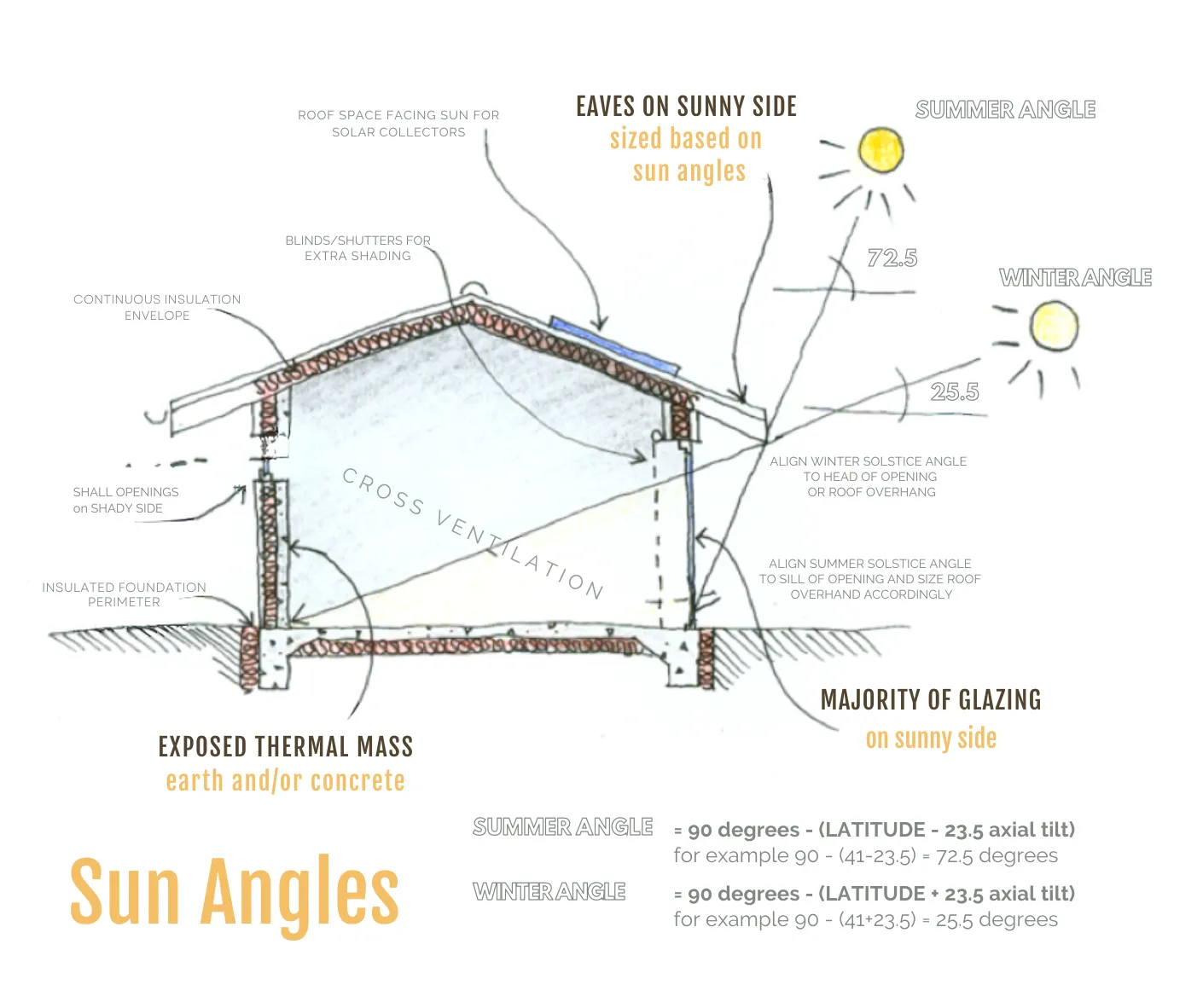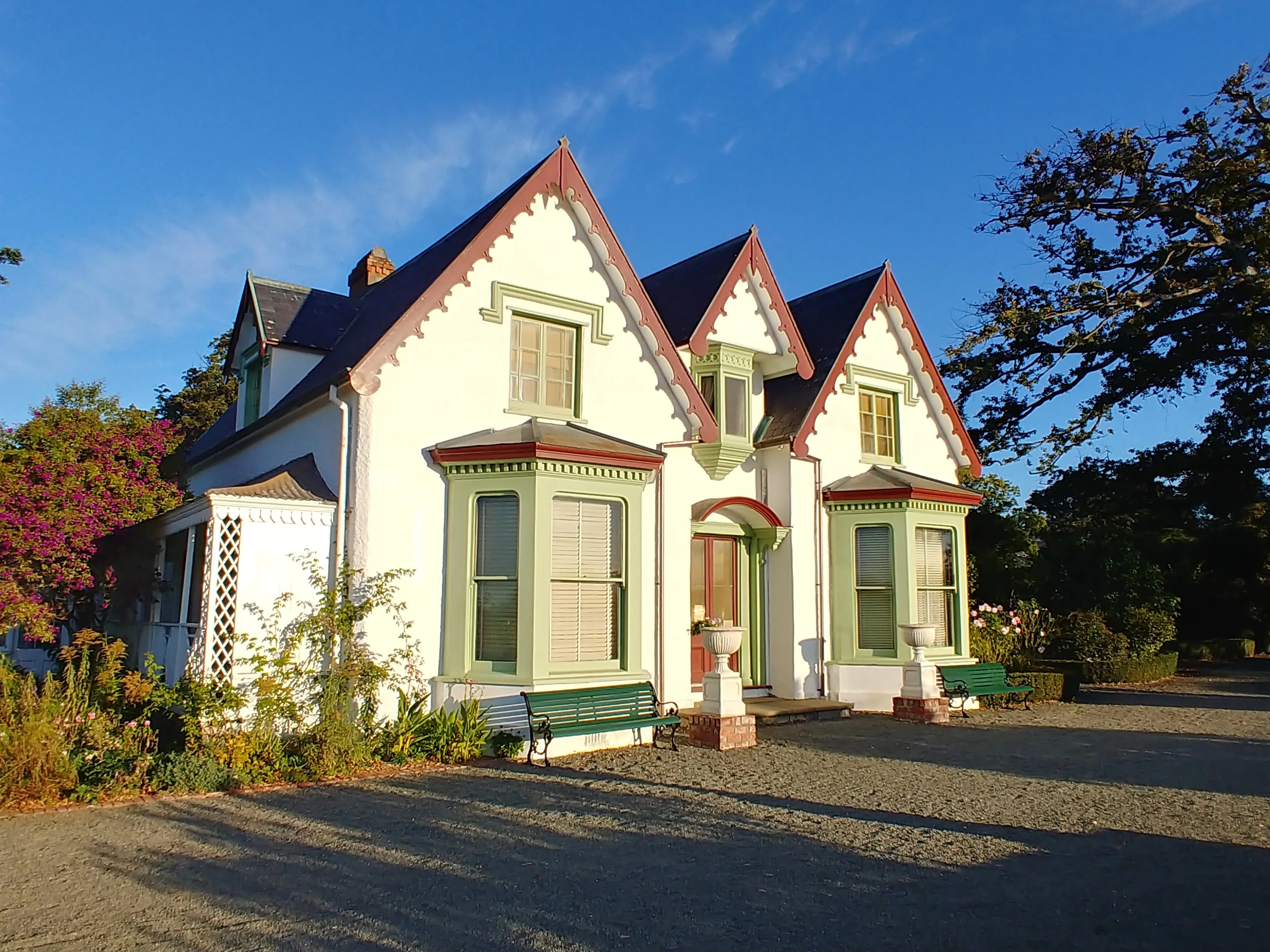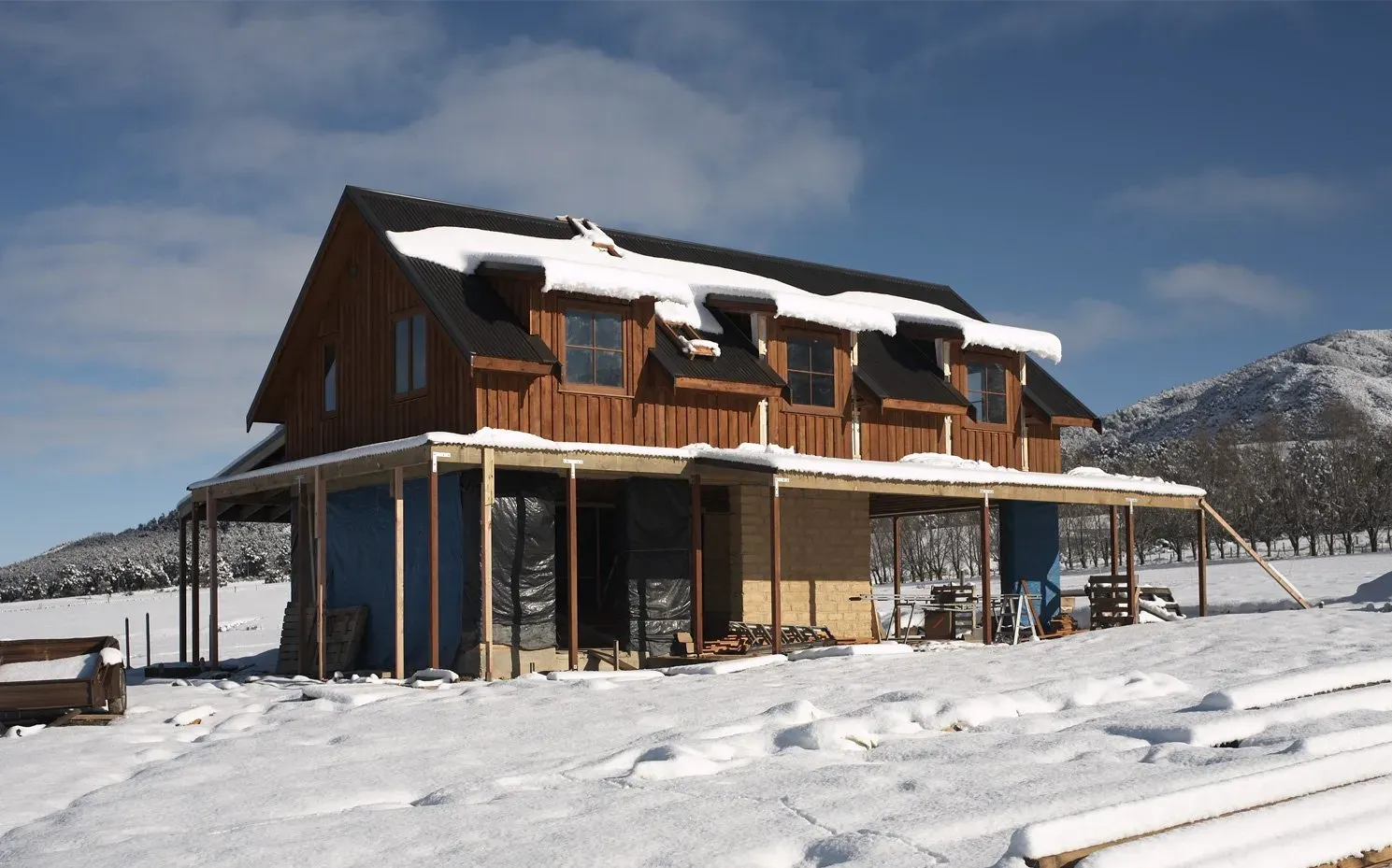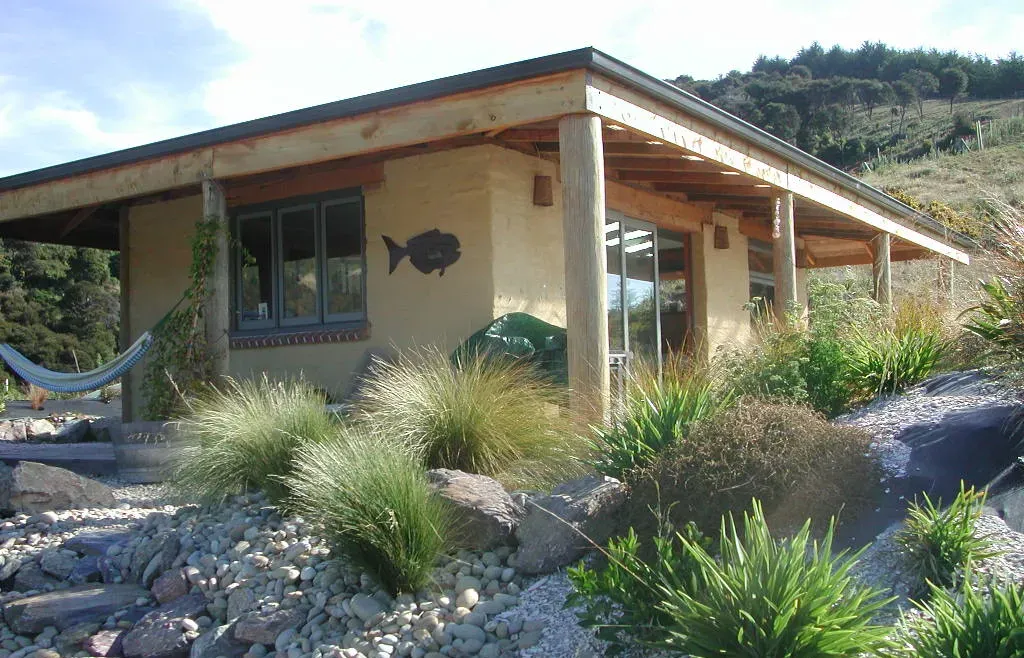Optimizing Sun Angles and Thermal Mass for Passive Solar Design in Any Climate
The saying “warm in winter, cool in summer” only really works for buildings who are optimized for solar gain and make strategic use of thermal mass and insulation. Most buildings are not designed to passive solar principles, even if modern regulations prescribe a high level of insulation for energy efficiency. They are more like well-insulated “boxes” that require active heating and cooling in order to be comfortable. We can do so much better with clever design!
Key Takeaways
- Understanding sun angles is crucial for optimizing passive solar heating and cooling.
- Thermal mass plays a key role in stabilizing indoor temperatures by storing and releasing heat.
- Correctly designed overhangs can provide shade during summer and allow solar gain in winter.
- Materials such as brick and earth are effective for thermal mass in passive solar design.
- Passive solar design principles can be adapted to any climate to improve energy efficiency.
Solar Savvy: Harnessing the Sun's Power
The sun is a powerful ally in achieving energy efficiency, and by understanding a few key principles, you can harness its full potential. Passive solar principles should be incorporated into any natural building design, as they complement natural mass materials such as earth, brick and stone particularly well.
Quick Guide: Understanding Passive Solar Design
Passive solar design is like a dance with the sun, where your home moves in harmony with the natural rhythms of daylight and seasons. The goal is to capture solar energy when you need warmth and deflect it when you need to cool down, all without relying on complex machinery and energy expenditure.
What You'll Learn About Sun Angles
Sun angles aren't just for astronomers. They're the secret ingredient in passive solar design, dictating how much sunlight enters your home throughout the year. Getting the angles right means you can soak up the sun in winter and find shade in summer.
Discovering the Power of Thermal Mass
Thermal mass is your home's memory for temperature. It's like a thermal battery, absorbing heat when there's excess and releasing it when things cool down. Using the right materials in the right places is crucial for making the most of this natural regulator.
Top Tips for Climate-Smart Solar Design
No matter where you live, from snowy cold places to the hot and humid ones, passive solar design can be tailored to your climate. It's all about balancing sun exposure, thermal mass, insulation and ventilation to create a comfortable, energy-efficient home year-round.
Maximizing Sunlight with Smart Design
Let's dive into the nitty-gritty of how to make the sun work for you. It all starts with understanding the path of the sun across your slice of the sky and using this knowledge to plan your home's layout, windows, and shading.
Picking the Perfect Angle

- Know your latitude: The angle of the sun changes with your location on the globe.
- Track the sun: Use tools like sun path charts to see how the sun moves in your area.
- Plan for the solstices: The sun's path is highest in summer and lowest in winter.
Getting your home's orientation right means you're halfway to a more sustainable and comfortable living space. A south-facing orientation (in the Northern Hemisphere) is usually the sweet spot for maximum solar gain in the winter months when the sun is low in the sky.
Why Sun Angles Matter
Why obsess over sun angles? Because they change with the seasons. In winter, you want to capture every precious ray of sunlight to naturally warm your home. But come summer, you'll be looking for ways to keep the heat at bay. It's all about the tilt of the Earth—yes, the same reason we have seasons is why sun angles are your best friend in passive solar design.
Tools for Tracking the Sun
You don't need to be an astrophysicist to track the sun. Simple tools like a sun path chart or even smartphone apps can show you exactly where the sun will be at any time of the year. Use this info to position your home and its windows for optimal solar gain.
Window Wisdom: Your Portal to Warmth
Windows are more than just a view outside; they're your home's solar collectors. But not all windows are created equal when it comes to passive solar design. It's about choosing the right type, size, and placement to make the sun your home's best friend.
Choosing the Right Windows
When selecting windows for passive solar design, think about these three things:
- Glazing: Look for double or triple-glazed windows to trap heat.
- Coatings: Low-emissivity (low-E) coatings can help control solar gain.
- Frames: Insulated frames prevent heat loss and improve overall efficiency.
But remember, bigger isn't always better. You want enough window area to let in sunlight, but too much glass can lead to overheating and energy loss. It's all about balance.
Strategic Placement for Optimal Gain
Place your windows where they can soak up the most sunlight when you need it. South-facing windows (again, in the Northern Hemisphere) are ideal for winter warmth, while north-facing windows will keep rooms cooler in the summer. For the Southern Hemisphere, it is the other way around. And don't forget about shading—properly sized eaves and strategically placed roof overhangs or deciduous plants can block the high summer sun while letting in the lower winter sun.
Shaping Shadows: The Art of Overhangs
Overhangs are like the eyebrows of your home—they provide shade and expression. Designed correctly, they block the hot summer sun while welcoming the lower-angled winter sun with open arms. It's a simple yet brilliant way to control temperature naturally.
Designing Overhangs to Keep Cool
Think of overhangs as your home's built-in sun visor. They are essential in managing solar gain, especially during hot summers. But how do you design an overhang that's both functional and stylish? Start with the sun's path—your overhang should be wide enough to shade your windows when the sun is high in the sky, but not so wide that it blocks the warming rays during cooler seasons.
Calculations for Year-Round Comfort
To calculate the perfect overhang depth, you'll need to consider the angle of the sun at midday during both summer and winter solstices. A simple formula involves using your latitude and the sun's altitude to determine the overhang length. This ensures that you get shade when you need it and sunlight when you don't. It's a clever way to stay comfortable without touching the thermostat.
The Magic of Thermal Mass
Now, let's talk about the heavyweight champion of passive solar design—thermal mass. This isn't just about using heavy materials; it's about using them smartly. The right thermal mass can absorb heat during the day and release it slowly at night, helping to maintain a constant temperature in your home. Different high mass materials will absorb and release heat at different speeds, which doesn’t make them all equal. Earthen materials for example, are slow reacting, which makes them ideal to even out temperature fluctuations in day-night cycles. Concrete, which also is high mass, reacts much faster, creating a less comfortable effect at times. Having a combination of different thermal mass materials gives the best results.
Materials That Store and Release Heat
When it comes to thermal mass, think dense and heat-absorbent. Materials like concrete, brick, and stone are fantastic at storing heat. But it's not just about picking the right materials; it's about placing them where they can do the most good—like floors and walls that get direct sunlight.
Here's the thing: not all materials are created equal when it comes to thermal mass. Some are better at storing heat, while others are better at releasing it. It's like choosing a team—everyone has a role to play for the win.
- Concrete: Great for floors, concrete stores and releases heat relatively quickly, buffering evening temperatures, but potentially not creating lasting thermal comforrt.
- Brick: This classic building material isn't just for looks; it's also a solid choice for thermal mass.
- Stone: Whether it's a stone wall or a tile floor, stone holds onto heat and lets it go gradually.
- Earth: Rammed earth or Adobe walls can be used as structural thermal mass, offering a sustainable choice. They are slow reacting, which means they even out temperature fluctuations over a longer period of time.
Where to Integrate Thermal Mass
So, where do you put all this heavy stuff? The best spots for thermal mass are where they'll get direct sunlight—in walls and floors that face the sun. But there's a catch: you need to balance your thermal mass with insulation. Too much mass without enough insulation is like a thermal leak, letting all that stored heat escape.
Balancing Temperatures Inside Your Home
You want your home to be like a thermal equilibrium ninja—absorbing and releasing heat at just the right times. Thermal mass can help even out the temperature swings between day and night, making your home more comfortable and reducing your reliance on heating and cooling systems.
Regulating Day and Night Temperature Shifts
Think of thermal mass as a buffer against temperature swings. During the day, it absorbs excess heat, preventing your home from becoming a sauna. At night, it releases that stored heat, warding off the chill. It's a natural cycle that keeps your living space more stable and much more comfy.
Layering Spaces for Thermal Efficiency
Designing your home with thermal efficiency in mind means thinking about how different spaces interact. For instance, placing a greenhouse or sunroom on the sunny side can capture heat during the day, which can then be distributed throughout the house. It's like setting up dominoes to fall just the way you want them to—each space warming the next.
Designing for Different Climates
Whether you're basking in the sun or bracing against the cold, passive solar design can be customized for your climate. Let's explore how to make the most of the sun's gifts, while responding to your climate and location.
Chilly Climates: Let the Sun In
If you're living in a colder climate, you'll want to invite as much sunlight as possible into your home to take advantage of free solar heating. Large, south-facing windows and plenty of thermal mass to store that heat are key. But don't forget about insulation—it's what keeps that precious warmth from slipping away.
Optimize Solar Heat Gain for Cold Areas
Maximizing solar heat gain in cold areas means playing a strategic game with the sun. Position your home and windows to capture the low-angled winter sun, and use materials with good thermal mass to store that heat. Then, insulate like your life depends on it—because it does.
Remember, the winter sun is low in the sky, so you want to capture as much of it as you can. That means larger windows on the sunny side and minimizing windows on the cold side where heat loss is more likely.
- Use double- or triple-glazed windows for better insulation.
- Integrate thermal mass in floors and walls that receive sunlight. Retrofitting earthen panels or bricks works well.
- Insulate roof, floor and walls to keep the heat inside.
- Make sure there aren’t any air leaks or cold bridges in the construction.
Hot and Humid: Passive Cooling and Ventilation
In hot and humid climates, the goal is to keep the heat out and promote airflow to cool down naturally. Here's where overhangs, reflective materials, and strategic landscaping come into play. It's like setting up a cool, shady oasis right in and around your home.
Design Features that Beat the Heat
Designing for heat means thinking like the sun is your frenemy—you appreciate its light but could do without the heat. Use reflective roofing materials, light-colored exterior finishes, and shade trees to deflect the sun's rays. Overhangs and porches create shaded areas that help keep your home cooler. Thermal mass away from solar gain and in touch with air flow can contribute to a more comfortable home, and depending on the materials you use, can regulate humidity which will affect comfort too.
Natural Ventilation Techniques
Natural ventilation is all about encouraging breezes to flow through your home, whisking away the heat. Position windows and doors to catch the prevailing winds, and consider features like clerestory windows or vented skylights to draw hot air up and out. It's like giving your home a set of lungs to breathe in the cool and exhale the warm.
Seal the Deal: Insulation and Air Tightness
Insulation is your home's secret weapon against energy loss. It's what keeps the heat inside during winter and outside during summer. But insulation is only as good as the air tightness of your home. Even the best insulation won't do much if there are drafts letting all that controlled air escape.
- Choose the right type and amount of insulation for your climate.
- Seal gaps and cracks to prevent air leaks.
- Consider the insulation's R-value, which measures its resistance to heat flow.
Combining insulation with air tightness creates a thermal barrier that is both efficient and effective. Think of it like a thermos—it keeps hot things hot and cold things cold by not allowing air to sneak in or out.
Insulation isn't just for walls and attics; it's also important for floors, especially if you have a basement or crawlspace. Insulating these areas can prevent cold feet in the winter and keep your home's foundation stable.
Wrapping Up Warmth: Insulation Basics
When it comes to insulation, there's a variety of natural options to choose from: straw, cellulose, wool, cork and hemp panels are all options. Each has its own benefits and ideal applications, so it's important to understand which type works best for your specific needs and is available to you locally.
Insulation is measured by its R-value, which tells you how well it resists heat flow. The higher the R-value, the better the insulation will perform. But remember, more isn't always better—you want the right amount of insulation for your climate and home design.
Choosing Insulation for Your Climate
Insulation needs vary by climate. In colder regions, you'll need a higher R-value to keep the heat in. In warmer areas, you might focus more on keeping the heat out. The Department of Energy has guidelines for recommended R-values based on where you live.
Sealing the Envelope: Where Air Tightness Matters
- Doors and windows: Use weatherstripping and caulk to seal gaps.
- Electrical outlets and switches: Insulate behind plates on exterior walls.
- Ducts: Seal and insulate ductwork to prevent loss of heated or cooled air.
Ensuring your home is airtight is like battening down the hatches on a ship; you're preparing for the onslaught of weather by making sure there are no weak spots for energy to escape.
Remember, while air tightness is a must, ventilation is still important for air quality. Use strategic ventilation to bring in fresh air without losing energy efficiency.
FAQs About Passive Solar Design
Let's address some common questions about passive solar design. This is where we can clear up any confusion and help you understand how to apply these principles to your own home.
What Is the Best Orientation for Passive Solar Design?
The best orientation for passive solar design is typically true south in the Northern Hemisphere and true north in the Southern Hemisphere. This allows your home to take full advantage of the sun's path for optimal solar gain in winter and minimal heat intake in summer.
How Do You Calculate the Necessary Thermal Mass?
To calculate the necessary thermal mass, you need to consider the size of your sun-facing windows and the intensity of the sun in your area. A general rule of thumb is about 6 times the area of the sun-facing glazing in thermal mass (measured in square feet or square meters).
Can Passive Solar Design Be Applied to Any Home?
Yes, passive solar design principles can be applied to any home, new or existing. However, the effectiveness of these strategies will vary based on factors like location, climate, and existing structure. Retrofitting an existing home might require creative solutions to optimize solar gain.
How Do Overhangs Contribute to Passive Solar Heating?
Overhangs contribute to passive solar heating by blocking high-angle summer sun, thus reducing overheating, and allowing low-angle winter sun to enter and warm the home. The design and depth of the overhangs are calculated based on the latitude and the specific sun angles throughout the year.
What Are Common Mistakes to Avoid in Passive Solar Design?
Common mistakes in passive solar design include:
- Ignoring local climate and sun path when designing.
- Overglazing, which can lead to overheating and high heat loss.
- Insufficient insulation and air sealing, which can negate the benefits of solar gain.
- Lack of thermal mass to store and release heat.
- Not considering the balance between heating, cooling, and ventilation needs.
Avoiding these pitfalls is essential for creating a home that is comfortable, energy-efficient, and truly in sync with its environment. With careful planning and a bit of solar savvy, you can create a space that works with the sun to provide natural comfort all year round.







